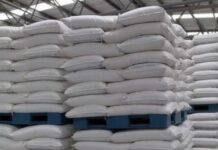Indian policymakers face a critical decision regarding sugar exports. While supporters of export curbs argue that they help control food inflation, there are unintended consequences. Artificially cheap sugar incentivizes its use in processed foods, leading to health issues. Moreover, the weight of sugar in overall inflation is minimal. Instead, high cereal prices and seasonal fluctuations in perishable goods play a more significant role. To manage food inflation effectively, India must address broader agricultural challenges, including post-harvest infrastructure and market-distorting policies. Favorable sugar production results indeed provide a compelling argument for lifting the ban on sugar exports. As production surpluses accumulate, it becomes essential to explore international markets. By doing so, India can not only support its farmers and sugar factories but also contribute to global trade dynamics. However, policymakers must strike a balance to ensure domestic availability and stability while reaping the benefits of export opportunities.
IMPORTANCE OF ACCURATE SUGARCANE PRODUCTION ESTIMATES: Accurate sugar cane production estimates play a crucial role in preventing misguided decisions and policy measures. Let’s delve into the significance of accurate estimates:
1) Market Stability and Trade: Reliable estimates help stabilize the sugar market by ensuring adequate supply. When estimates are inaccurate, it can lead to export bans or shortages, affecting both domestic and international trade1.
2) Ethanol Production: Accurate estimates are essential for planning ethanol production from sugar cane. The Indian government’s decision to allow ethanol production directly from sugarcane juice aims to optimize resource utilization and reduce surplus sugar production.
3) Environmental Impact: Precise estimates guide sustainable cultivation practices. For instance, using B-heavy molasses for ethanol production can reduce waste and promote eco-friendly practices.
4) Energy Security: Sugar cane is a biofuel feedstock. Accurate yield predictions help ensure a stable supply for bioenergy production, contributing to energy security4.
5) Logistical Efficiency: Timely yield estimates aid in efficient logistical management, benefiting the entire sugar industry.
In summary, accurate sugar cane production estimates are vital for informed decision-making, sustainable practices, and economic stability.
FEAR OF RISING SUGAR PRICES IMPACTED THE SUGAR EXPORT DECISION: The surge in global sugar prices has had significant repercussions, especially in developing nations like India and hence during the sugar season 2023-24, due to low production estimates, there was fear about rise in sugar prices which influenced delay in sugar export decisions:
1) Rising Sugar Prices: Sugar prices have more than doubled in the past two months due to lower global supplies caused by unusually dry weather damaging harvests in India and Thailand. This phenomenon is attributed to El Nino, which shifts global weather patterns.
2) Impact on Voters: Rising sugar prices directly affects citizens.
3) Food Inflation: Combined with other factors like the war in Ukraine and weaker currencies, high sugar prices contribute to food inflation.
4) Developing nations face challenges in absorbing these costs, affecting voters’ well-being.
5) Policy Delays: Given the severity of the situation, policymakers may delay sugar export decisions to mitigate domestic shortages and address voter concern.
Hence, the fear of rising sugar prices has real-world consequences, affecting both citizens and policy choices.
HOW SUGAR EXPORT BAN IN INDIA IMPACTED ON FARMERS AND SUGAR INDUSTRY: The recent sugar export ban in India had notable impacts on both farmers and the industry:
1) Farmers: Implicit Taxation: Export bans effectively impose an implicit tax on Indian farmers. By restricting sugar exports, the government aims to stabilize domestic prices, which results in low income to sugar factories and this can adversely affect farmers due to delay in their cane price payments from the sugar factories.
2) Supply Glut: With limited export options, sugar mills may accumulate excess stock, leading to storage challenges and potential losses to the factories.
3) Market Disruptions: The ban disrupted the sugar industry’s export-oriented operations. Mills had to adjust production and distribution strategies, impacting supply chains and logistics.
4) Price Volatility: The restriction aimed to stabilize domestic prices, but it also introduced uncertainty. Industry players had to navigate fluctuating prices and demand dynamics.
5) Export Decline: India’s sugar exports surged significantly in recent years, but the ban led to a decline in exports. This affected industry revenues and global market share.
In summary, while the export ban aimed to manage domestic availability and prices, it had implications for farmers’ income and industry operations.
FINANCIAL STRAIN ON SUGAR FACTORIES DUE TO BAN ON EXPORT: The ban on sugar exports in India has placed significant financial strain on sugar factories. Here’s how:
1) Export Restrictions: India, the world’s second-largest sugar exporter after Brazil, is expected to ban mills from exporting sugar for the first time in seven years due to a lack of rain and reduced cane yields. This restriction directly impacts the revenue streams of sugar factories that rely on international markets.
2) Revenue Loss: Sugar factories typically generate income by exporting surplus sugar. With the ban in place, they lost a crucial revenue source when their international sugar prices were at a higher side. The inability to access global markets affects their financial stability.
3) Storage Challenges: Sugar factories may have excess stock due to limited export options. Storing surplus sugar becomes a logistical challenge, potentially leading to additional costs.
4) Market Uncertainty: The ban disrupts industry operations and introduces uncertainty. Factories must adjust production and distribution strategies, affecting supply chains and logistics.
In summary, the ban on sugar exports has strained the financial health of sugar factories, impacting their revenue, storage, and overall stability.
INDIAN SUGAR INDUSTRY IS A ESSENTIAL ECONOMIC SECTOR RATHER THAN A SOLELY POLITICAL VIEWPOINTS: The Indian sugar industry holds immense economic significance beyond just political considerations. Here’s why:
1)Employment Generation: The sugar industry provides direct and indirect employment to millions of people. From farmers cultivating sugarcane to factory workers, transporters, and traders, it contributes significantly to livelihoods.
2) Rural Economy: Sugarcane cultivation is predominantly rural. It injects capital into rural areas, supporting local businesses and infrastructure development.
3) Foreign Exchange Earnings: Sugar exports contribute to India’s foreign exchange reserves. The industry earns valuable foreign currency by selling sugar, molasses, and ethanol abroad.
4) Agro-Industrial Linkages: The sugar industry has strong linkages with other sectors. It supports machinery manufacturers, logistics, packaging, and chemical industries.
5) By-Products: Apart from sugar, the industry produces molasses (used in alcohol production), bagasse (for energy), and press mud (used as fertilizer). These by-products have economic value.
6) Energy Production: Bagasse-based cogeneration produces electricity, reducing dependence on fossil fuels. This contributes to energy security and environmental sustainability.
7) Investment and Technology: The industry attracts investments in modernizing mills, improving yield, and adopting advanced technologies.
In summary, the Indian sugar industry plays a pivotal role in the economy, impacting livelihoods, trade, and rural development. Hence, it should be treated as “INDUSTRY “ keeping aside any political approach.
INTERCONNECTEDNESS OF THE INDIAN SUGAR INDUSTRY WITH THE FARMERS, WORKERS AND THE OVERALL ECONOMY: The Indian sugar industry is intricately connected to farmers, workers, and the broader economy.
Farmers:
a) Cultivation: Sugarcane farmers form the backbone of the industry. They grow the raw material (sugarcane) that feeds the factories.
b) Income Source: Sugarcane cultivation provides livelihoods for millions of farmers. Their income depends on successful harvests and fair prices.
c) Cooperative Model: Many sugar factories operate as cooperatives, with farmers as shareholders. This model ensures farmer participation in decision-making.
Workers:
a) Factory Labor: Workers in sugar mills handle crushing, processing, and packaging. Their labor directly impacts sugar production.
b) Seasonal Employment: The industry provides seasonal employment during cane crushing, benefiting local communities.
c) Skill Development: Workers gain skills in agro-processing, machinery operation, and logistics.
Overall Economy:
a) Revenue Generation: The sugar industry contributes to state and national revenues through taxes, export earnings, and other economic activities.
b) Supply Chain: It fuels a supply chain involving transport, logistics, and packaging industries.
c)By-Products: Beyond sugar, it produces molasses (for alcohol), bagasse (for energy), and press mud (as fertilizer).
In summary, the Indian sugar industry’s success relies on collaboration among farmers, workers, and the broader economy.
LIFTING THE BAN ON EXPORT OF SUGAR WILL INJECT THE BEFITS TO FACTORIES AND FARMERS: Lifting the ban on sugar exports can indeed have significant benefits for both farmers and sugar factories. Let’s explore these aspects:
Farmers:
a) Increased Revenue: Export opportunities allow factories to sell surplus sugar in international markets. This additional revenue will be utilised for the clearing the due sugarcane price. Timely payments to the farmers will support their livelihoods and provide financial stability. As on today, there is ₹500/- crores Sugarcane dues owed to the farmers around the country.
b) Market Diversification: Access to global markets reduces dependence on domestic buyers, mitigating risks associated with local price fluctuations.
Sugar Factories:
a) Liquidity Injection: Export revenue injects liquidity into sugar factories. This helps cover operational costs, debt servicing, and modernization efforts.
b)Utilisation of Surplus: Factories can utilize surplus sugar efficiently by exporting it, preventing oversupply and market disruptions.
c) Industry Competitiveness: Export-oriented factories remain competitive, contributing to the overall health of the sugar industry.
Economic Impact:
a) Foreign Exchange Earnings: Sugar exports earn valuable foreign currency, benefiting the national economy.
b) Job Creation: A thriving sugar industry sustains employment across the value chain, from cultivation to processing and logistics.
In summary, lifting the export ban promotes liquidity, stability, and growth, benefiting both farmers and sugar factories.
PRESENT POSITION OF FAVOURABLE SUGAR BALANCE SHEET OF THE COUNTRY NEEDS SUGAR EXPORT: The need for sugar export is indeed a relevant topic, especially given the current market dynamics. Let’s delve into some key statistics and points which explore the favourable situation to lift the ban on export and the announcement of the policy of sugar export giving priority.
1) Current Sugar Stock Situation: As of September 2024, the end stock of sugar is projected to be 87 lakhs (8.7 million) metric tons (MT).
2) The buffer stock requirement: For maintaining buffer stock, the required quantity is 60 lakhs (6 million) MT.
3) Market Dynamics: International sugar prices have been on the rise, creating favorable conditions for exports.
4) Sugar factories are facing financial challenges due to various factors, including production costs and market fluctuations.
5) Export Potential: Considering the surplus stock and quality requirements, allowing the export of at least 20 lakhs (2 million) MT seems prudent. Exporting excess sugar can help alleviate financial strain on domestic producers.
6 Benefits of Export:
a) Foreign exchange earnings: Sugar exports contribute to the country’s foreign reserves.
b) Market stability: Exporting surplus sugar helps balance supply and demand globally.
c) Industry viability: Facilitating exports can support sugar factories and sustain employment.
Amidst growing concerns about the impact of the ban on sugar exports, Indian sugar factories Associations like National Federation of Cooperative Sugar Factories and Indian Sugar Mills Association have urged the government to reconsider its stance. The ban not only affects farmers’ income but also disrupts trade dynamics. As the debate continues, finding a balanced solution that benefits both farmers and the economy remains crucial. Being a favourable stock position of sugar in the country, sugar industry of the country which is facing financial stringency, is eagerly waiting for the favourable policy announcement from the Union Govt.about export of sugar giving Top-Priority. We hope the Union Government will look into the matter urgently and by lifting the ban on sugar export, allow at-least 20 lakhs MT of sugar to export out of India.
P.G. Medhe is the former Managing Director of Shri Chhatrapati Rajaram Sahakari Sakhar Karkhana Ltd and sugar industry analyst. He can be contacted at +91 9822329898.
To read more about the news about the Sugar industry and Ethanol Industry, continue reading Chinimandi.com.












